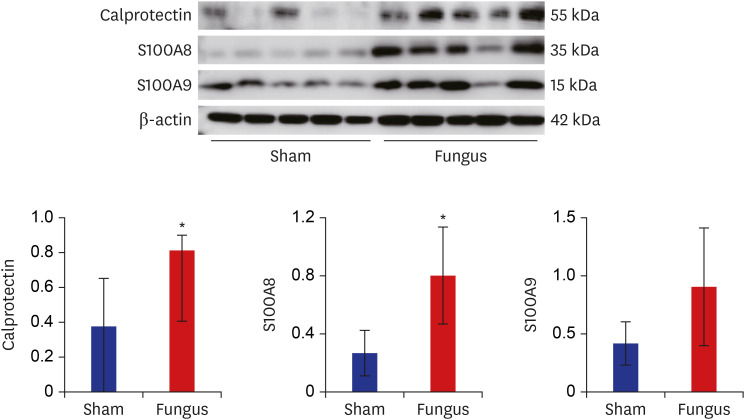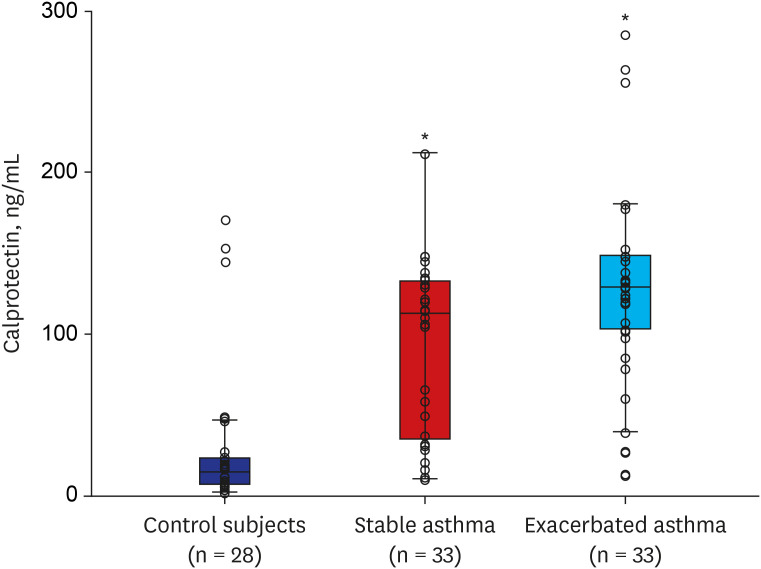J Korean Med Sci.
2020 Nov;35(43):e362. 10.3346/jkms.2020.35.e362.
Serum Calprotectin Is a Potential Marker in Patients with Asthma
- Affiliations
-
- 1Division of Allergy and Respiratory Medicine, Department of Internal Medicine, Soonchunhyang University Bucheon Hospital, Bucheon, Korea
- KMID: 2508500
- DOI: http://doi.org/10.3346/jkms.2020.35.e362
Abstract
- Background
Calprotectin is the major cytosolic protein in neutrophil granulocytes. Although asthma is known to cause eosinophilic inflammation, some patients with asthma have non-eosinophilic inflammation, which is characterized by local neutrophilic inflammation. The aim of this study was to assess calprotectin expression levels in a mouse model of asthma, and to observe the relationship of serum calprotectin level and clinical variables in patients with asthma.
Methods
Mice were sensitized and challenged with 10 μg and 20 μg of Aspergillus fumigatus, respectively; mice treated with saline were used as a control. The levels of calprotectin were determined using enzyme-linked immunosorbent assay, immunoblotting, and immunohistochemical analysis. The serum levels of calprotectin were also assessed in patients with asthma. The relationship between calprotectin and clinicopathological characteristics was determined.
Results
Calprotectin, S100A8, and S100A9 expression was elevated in the mouse lungs, Calprotectin levels were higher in the serum of patients with asthma (n = 33) compared with those of healthy individuals (n = 28). Calprotectin levels correlated with forced expiratory volume in one second/forced vital capacity (r = −0.215, P = 0.043), smoke amount (r = 0.413, P = 0.017), body mass index (r = −0.445,P= 0.000), and blood neutrophil percentage (r = 0.300, P = 0.004) in patients with asthma.
Conclusion
Our data suggest that calprotectin could potentially be used as a biomarker for asthma.
Keyword
Figure
Reference
-
1. Manni ML, Alcorn JF. Calprotectin-g the lung during type 2 allergic airway inflammation. Am J Respir Cell Mol Biol. 2019; 61(4):405–407. PMID: 31046403.
Article2. Carr TF, Zeki AA, Kraft M. Eosinophilic and noneosinophilic asthma. Am J Respir Crit Care Med. 2018; 197(1):22–37. PMID: 28910134.
Article3. Ricciuto A, Griffiths AM. Clinical value of fecal calprotectin. Crit Rev Clin Lab Sci. 2019; 56(5):307–320. PMID: 31088326.
Article4. Manceau H, Chicha-Cattoir V, Puy H, Peoc'h K. Fecal calprotectin in inflammatory bowel diseases: update and perspectives. Clin Chem Lab Med. 2017; 55(4):474–483. PMID: 27658156.
Article5. Lin WC, Wong JM, Tung CC, Lin CP, Chou JW, Wang HY, et al. Fecal calprotectin correlated with endoscopic remission for Asian inflammatory bowel disease patients. World J Gastroenterol. 2015; 21(48):13566–13573. PMID: 26730169.
Article6. Wang S, Song R, Wang Z, Jing Z, Wang S, Ma J. S100A8/A9 in inflammation. Front Immunol. 2018; 9:1298. PMID: 29942307.
Article7. Oczypok EA, Milutinovic PS, Alcorn JF, Khare A, Crum LT, Manni ML, et al. Pulmonary receptor for advanced glycation end-products promotes asthma pathogenesis through IL-33 and accumulation of group 2 innate lymphoid cells. J Allergy Clin Immunol. 2015; 136(3):747–756.e4. PMID: 25930197.
Article8. Hammad H, Chieppa M, Perros F, Willart MA, Germain RN, Lambrecht BN. House dust mite allergen induces asthma via Toll-like receptor 4 triggering of airway structural cells. Nat Med. 2009; 15(4):410–416. PMID: 19330007.
Article9. Aoki T, Matsumoto Y, Hirata K, Ochiai K, Okada M, Ichikawa K, et al. Expression profiling of genes related to asthma exacerbations. Clin Exp Allergy. 2009; 39(2):213–221. PMID: 19187333.
Article10. Gray RD, MacGregor G, Noble D, Imrie M, Dewar M, Boyd AC, et al. Sputum proteomics in inflammatory and suppurative respiratory diseases. Am J Respir Crit Care Med. 2008; 178(5):444–452. PMID: 18565957.
Article11. Lee TH, Jang AS, Park JS, Kim TH, Choi YS, Shin HR, et al. Elevation of S100 calcium binding protein A9 in sputum of neutrophilic inflammation in severe uncontrolled asthma. Ann Allergy Asthma Immunol. 2013; 111(4):268–275.e1. PMID: 24054362.
Article12. Lee TH, Chang HS, Bae DJ, Song HJ, Kim MS, Park JS, et al. Role of S100A9 in the development of neutrophilic inflammation in asthmatics and in a murine model. Clin Immunol. 2017; 183:158–166. PMID: 28847516.
Article13. Zhao J, Endoh I, Hsu K, Tedla N, Endoh Y, Geczy CL. S100A8 modulates mast cell function and suppresses eosinophil migration in acute asthma. Antioxid Redox Signal. 2011; 14(9):1589–1600. PMID: 21142608.
Article14. Yin LM, Li HY, Zhang QH, Xu YD, Wang Y, Jiang YL, et al. Effects of S100A9 in a rat model of asthma and in isolated tracheal spirals. Biochem Biophys Res Commun. 2010; 398(3):547–552. PMID: 20599758.
Article15. Greenlee KJ, Corry DB, Engler DA, Matsunami RK, Tessier P, Cook RG, et al. Proteomic identification of in vivo substrates for matrix metalloproteinases 2 and 9 reveals a mechanism for resolution of inflammation. J Immunol. 2006; 177(10):7312–7321. PMID: 17082650.
Article16. Schuh JM, Blease K, Kunkel SL, Hogaboam CM. Eotaxin/CCL11 is involved in acute, but not chronic, allergic airway responses to Aspergillus fumigatus . Am J Physiol Lung Cell Mol Physiol. 2002; 283(1):L198–204. PMID: 12060577.17. Lee SH, Lee PH, Kim BG, Seo HJ, Baek AR, Park JS, et al. Annexin A1 in plasma from patients with bronchial asthma: its association with lung function. BMC Pulm Med. 2018; 18(1):1. PMID: 29301525.
Article18. Global Initiative for Asthma (GINA). Global strategy for asthma management and prevention 2014. Updated 2014. Accessed May 14, 2014. http://www.ginasthma.org/.19. Sur S, Crotty TB, Kephart GM, Hyma BA, Colby TV, Reed CE, et al. Sudden-onset fatal asthma. A distinct entity with few eosinophils and relatively more neutrophils in the airway submucosa? Am Rev Respir Dis. 1993; 148(3):713–719. PMID: 8368644.
Article20. Jatakanon A, Uasuf C, Maziak W, Lim S, Chung KF, Barnes PJ. Neutrophilic inflammation in severe persistent asthma. Am J Respir Crit Care Med. 1999; 160(5 Pt 1):1532–1539. PMID: 10556116.
Article21. Louis R, Lau LC, Bron AO, Roldaan AC, Radermecker M, Djukanović R. The relationship between airways inflammation and asthma severity. Am J Respir Crit Care Med. 2000; 161(1):9–16. PMID: 10619791.
Article22. Green RH, Brightling CE, Woltmann G, Parker D, Wardlaw AJ, Pavord ID. Analysis of induced sputum in adults with asthma: identification of subgroup with isolated sputum neutrophilia and poor response to inhaled corticosteroids. Thorax. 2002; 57(10):875–879. PMID: 12324674.
Article23. Norzila MZ, Fakes K, Henry RL, Simpson J, Gibson PG. Interleukin-8 secretion and neutrophil recruitment accompanies induced sputum eosinophil activation in children with acute asthma. Am J Respir Crit Care Med. 2000; 161(3 Pt 1):769–774. PMID: 10712320.
Article24. Semprini S, Capon F, Tacconelli A, Giardina E, Orecchia A, Mingarelli R, et al. Evidence for differential S100 gene over-expression in psoriatic patients from genetically heterogeneous pedigrees. Hum Genet. 2002; 111(4-5):310–313. PMID: 12384771.
Article25. Kinoshita R, Sato H, Yamauchi A, Takahashi Y, Inoue Y, Sumardika IW, et al. Newly developed anti-S100A8/A9 monoclonal antibody efficiently prevents lung tropic cancer metastasis. Int J Cancer. 2019; 145(2):569–575. PMID: 30414170.
Article26. Chernov AV, Dolkas J, Hoang K, Angert M, Srikrishna G, Vogl T, et al. The calcium-binding proteins S100A8 and S100A9 initiate the early inflammatory program in injured peripheral nerves. J Biol Chem. 2015; 290(18):11771–11784. PMID: 25792748.
Article27. Eisenblaetter M, Flores-Borja F, Lee JJ, Wefers C, Smith H, Hueting R, et al. Visualization of tumor-immune interaction - Target-specific imaging of S100A8/A9 reveals pre-metastatic niche establishment. Theranostics. 2017; 7(9):2392–2401. PMID: 28744322.
Article28. Gopal R, Monin L, Torres D, Slight S, Mehra S, McKenna KC, et al. S100A8/A9 proteins mediate neutrophilic inflammation and lung pathology during tuberculosis. Am J Respir Crit Care Med. 2013; 188(9):1137–1146. PMID: 24047412.
Article29. Cremers NA, van den Bosch MH, van Dalen S, Di Ceglie I, Ascone G, van de Loo F, et al. S100A8/A9 increases the mobilization of pro-inflammatory Ly6Chigh monocytes to the synovium during experimental osteoarthritis. Arthritis Res Ther. 2017; 19(1):217. PMID: 28969686.
Article30. Schiopu A, Cotoi OS. S100A8 and S100A9: DAMPs at the crossroads between innate immunity, traditional risk factors, and cardiovascular disease. Mediators Inflamm. 2013; 2013:828354. PMID: 24453429.
Article31. Wu Y, Li Y, Zhang C, A X, Wang Y, Cui W, et al. S100A8/A9 released by CD11b+Gr1+ neutrophils activates cardiac fibroblasts to initiate angiotensin II-Induced cardiac inflammation and injury. Hypertension. 2014; 63(6):1241–1250. PMID: 24711518.32. Huang H, Huang Q, Tang T, Gu L, Du J, Li Z, et al. Clinical significance of calcium-binding protein S100A8 and S100A9 expression in non-small cell lung cancer. Thorac Cancer. 2018; 9(7):800–804. PMID: 29733516.
Article33. Wilkerson EM, Johansson MW, Hebert AS, Westphall MS, Mathur SK, Jarjour NN, et al. The peripheral blood eosinophil proteome. J Proteome Res. 2016; 15(5):1524–1533. PMID: 27005946.
Article34. Kalla R, Kennedy NA, Ventham NT, Boyapati RK, Adams AT, Nimmo ER, et al. Serum calprotectin: a novel diagnostic and prognostic marker in inflammatory bowel diseases. Am J Gastroenterol. 2016; 111(12):1796–1805. PMID: 27596694.
Article35. Gray RD, Imrie M, Boyd AC, Porteous D, Innes JA, Greening AP. Sputum and serum calprotectin are useful biomarkers during CF exacerbation. J Cyst Fibros. 2010; 9(3):193–198. PMID: 20299288.
Article36. Kopeć-Mędrek M, Widuchowska M, Kucharz EJ. Calprotectin in rheumatic diseases: a review. Reumatologia. 2016; 54(6):306–309. PMID: 28115781.
Article37. Decaesteker T, Seys S, Hox V, Dilissen E, Marijsse G, Manhaeghe L, et al. Serum and sputum calprotectin, a reflection of neutrophilic airway inflammation in asthmatics after high-altitude exposure. Clin Exp Allergy. 2017; 47(12):1675–1677. PMID: 28992401.
Article38. Pham DL, Yoon MG, Ban GY, Kim SH, Kim MA, Ye YM, et al. Serum S100A8 and S100A9 enhance innate immune responses in the pathogenesis of Baker's asthma. Int Arch Allergy Immunol. 2015; 168(2):138–146. PMID: 26745257.
Article39. Caimmi C, Bertoldo E, Venturini A, Caramaschi P, Frulloni L, Ciccocioppo R, et al. Relationship between increased fecal calprotectin levels and interstitial lung disease in systemic sclerosis. J Rheumatol. 2019; 46(3):274–278. PMID: 30442820.
Article40. Polosa R, Thomson NC. Smoking and asthma: dangerous liaisons. Eur Respir J. 2013; 41(3):716–726. PMID: 22903959.
Article
- Full Text Links
- Actions
-
Cited
- CITED
-
- Close
- Share
- Similar articles
-
- A Prognostic Marker in Idiopathic Sudden Sensorineural Hearing Loss: Serum Calprotectin
- Can Fecal Calprotectin Level Be Used as a Markers of Inflammation in the Diagnosis and Follow-Up of Cow's Milk Protein Allergy?
- Eosinophil cationic protein in relation to bronchial hyperresponsiveness in asthmatic children
- Clinical Utility of Fecal Neutrophil Gelatinase-Associated Lipocalin and Calprotectin as Biomarkers of Clostridioides (Clostridium) difficile Infection
- Serum eosinophil cathionic protein and tryptase concentrations in atopic asthmatic patients after allergen bronchial challenge






